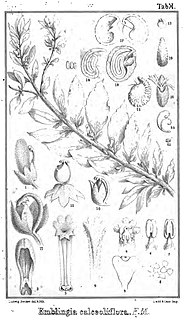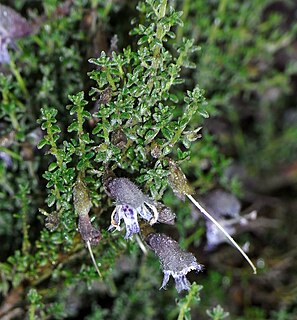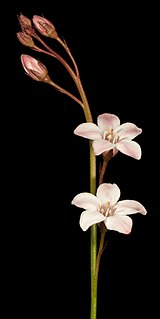
Alternanthera is a genus of flowering plants in the family Amaranthaceae. It is a widespread genus with most species occurring in the tropical Americas, and others in Asia, Africa, and Australia. Plants of the genus may be known generally as joyweeds, or Joseph's coat. Several species are notorious noxious weeds.
Banksia lepidorhiza is a species of prostrate shrub that is endemic to Western Australia. It has underground stems, linear pinnatipartite leaves with sharply pointed lobes, pink, cream-coloured and yellow flowers in head of about thirty and egg-shaped follicles. It is only known from near Woodanilling.
Banksia plumosa is a species of shrub that is endemic to Western Australia. It has hairy stems, broadly linear pinnatifid to pinnatipartite leaves with triangular lobes, creamy-yellow flowers in heads of up to eighty, and egg-shaped follicles.
Banksia tortifolia is a small, spreading, prostrate shrub that is endemic to the southwest of Western Australia. It has short underground stems, pinnatipartite leaves with sharply-pointed, linear lobes on each side, greenish-cream, yellow and pink flowers in heads of about eighty, and glabrous, egg-shaped follicles.

Emblingia is a monospecific plant genus containing the species Emblingia calceoliflora, a herbaceous prostrate subshrub endemic to Western Australia. It has no close relatives, and is now generally placed alone in family Emblingiaceae.

Eremophila denticulata, also known as toothed eremophila, toothed poverty bush and Fitzgerald eremophila, is a flowering plant in the figwort family, Scrophulariaceae and is endemic to the south-west of Western Australia. It is an erect shrub with red flowers and leaves that have toothed margins.

Dipodium, commonly known as hyacinth orchids, is a genus of about forty species of orchids native to tropical, subtropical and temperate regions of south-east Asia, New Guinea, the Pacific Islands and Australia. It includes both terrestrial and climbing species, some with leaves and some leafless, but all with large, often colourful flowers on tall flowering stems. It is the only genus of its alliance, Dipodium.

Alternanthera bettzickiana, commonly known as calico-plant, is a species of flowering plant in the family Amaranthaceae. It is commonly used as an ornamental edging plant. Native to South America, its cultivar 'Red' is similar in appearance to some of the Alternanthera dentata and Alternanthera brasiliana varieties.
Persoonia prostrata is a plant in the family Proteaceae and is endemic to the northern tip of K'gari in Queensland, but is presumed to be extinct. It is similar to Persoonia stradbrokensis but is a prostrate shrub with smaller leaves and flowers.

Hakea cucullata, commonly known as hood-leaved hakea, cup hakea or scallop hakea, is a species of shrub in the family Proteaceae and is endemic to the south-west of Western Australia. An attractive shrub with unusual distinctive foliage and beautiful large pink, red or deep purple scented flowers.

Prostanthera serpyllifolia, commonly known as small-leaved mint-bush, is a species of flowering plant in the family Lamiaceae and is endemic to southern Australia. It is a small shrub with small egg-shaped leaves and bright pink to red or metallic bluish-green flowers.

Isopogon buxifolius is a species of plant in the family Proteaceae and is endemic to the south-west of Western Australia. It is an upright shrub with egg-shaped to elliptic or oblong leaves and clustered spikes of pink flowers.

Thelymitra canaliculata, commonly called the flushed sun orchid or blue sun orchid is a species of orchid in the family Orchidaceae and is endemic to the south-west of Western Australia. It has a single erect, fleshy leaf and up to twenty eight blue flowers with darker veins and sometimes flushed with pink. The lobe on top of the anther is blackish with a yellow crest.
Thelymitra latiloba, commonly called the wandoo sun orchid or wandoo shirt orchid, is a species of orchid in the family Orchidaceae and endemic to the south-west of Western Australia. It has a single erect, fleshy, channelled, dark green leaf and up to twelve blue flowers with darker blue veins and sometimes flushed with mauve. The lobe on top of the anther is wavy.
Anarthria scabra is an herbaceous plant found in Southwest Australia.

Persicaria prostrata, basionym Polygonum prostratum, is a species of flowering plant in the family Polygonaceae, native to Australia and perhaps New Zealand. It is known by the common name of creeping knotweed.

Alternanthera nodiflora is a species of flowering plant in the family Amaranthaceae. It is endemic to Australia, growing in all mainland states It is naturalised in Tasmania, over much of Africa, in Japan, and in Myanmar.

Samolus junceus in the family Primulaceae is a species of water pimpernel native to Western Australia.
Alternanthera angustifolia is a small herb in family Amaranthaceae found widely in inland Australia from northern Western Australia, the Northern Territory, South Australia, New South Wales to Queensland.

Patersonia lanata, commonly known as woolly patersonia, is a species of flowering plant in the family Iridaceae family and is endemic to the south of Western Australia. It is a tufted perennial herb with sword-shaped leaves and blue-violet flowers.













